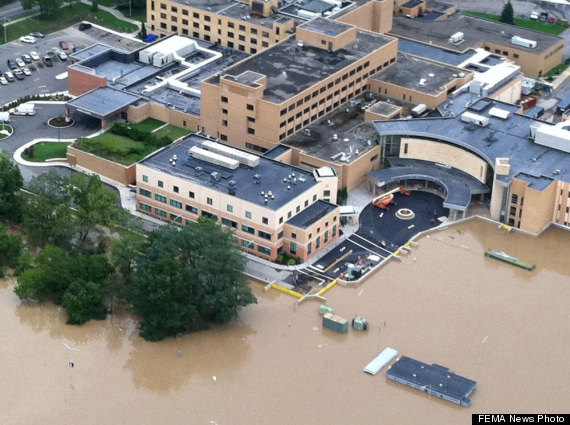
Binghamton, N.Y., September 8, 2011 -- A floodwall, built with hazard mitigation funds from the Federal Emergency Management Agency and New York State protected this vital property from flood waters that devastated other parts of the city, even as rising water from the Susquehanna River engulfed the hospital's parking lot during Tropical Storm Lee.
Do you ever notice in movies when a natural disaster hits, they always show doctors and nurses rushing around chaotic, overcrowded hospitals? There's a reason for that. We assume these massive infrastructures can withstand any hurricane, flood or tornado and continue offering healing and refuge during natural disasters.
We find comfort in knowing hospitals will be there for us when disaster strikes. But what the movies don't show is what it takes to effectively prepare hospitals for those disasters. And being unprepared can have disastrous consequences.
While visceral images and news reports convey the harrowing human condition in the immediate aftermath of natural disasters, we seldom acknowledge the long-term, crippling impact on our health care system. A full two years after Hurricane Katrina, the number of hospital beds in New Orleans was one-third of its pre-hurricane level. Just one of city's general hospitals was running at full capacity. Two others were partly open and the other four were still closed.
Unfortunately -- yet unsurprisingly -- climate related disasters are becoming a common reality for communities all over the world. However, as important and necessary leaders within their communities, hospitals are preparing to meet these disasters head on.
Here are five ways hospitals prepare for extreme weather events.
1. Reducing energy needs. During Superstorm Sandy, several hospitals were able to continuing operating and provide life-saving care because they had combined heat and power (CHP) systems. Also known as cogeneration, these systems produce heat and electricity from a single fuel source, such as natural gas or biomass, and they reduce strain on a community's energy infrastructure. The CHP system at Boston's Longwood Medical Area reduced fuel consumption by 24 percent at participating facilities. Another way to conserve energy is by retrocommissioning, which identifies low- or no-cost alternatives to energy-intensive operations (such as solar panels). It's effective and cost saving: Gundersen Health System saved over $1 million in energy expenses after going through its retrocommissioning process.
2. Rethinking design. Essential services and infrastructure that are well protected can determine the fate of a hospital during extreme flooding. After Katrina knocked the Veteran Affairs medical facility out of service, hospital administrators took an "upside-down" approach to its redesign, putting the emergency room, electrical units and generators, and kitchens on the higher floors. When Tropical Storm Lee flooded Binghamton, New York, Our Lady of Lourdes hospital was saved by a massive floodwall.
3. Relying on the community. During extreme weather events, hospitals are only as strong as the community around it. People flock to hospitals when disaster hits because hospitals are seen as safe, whether health services are needed. Ensuring other support services are in place throughout the community is key to reducing the crippling burden hospitals face. Emergency shelters; water, food, and energy supply chains; and social services are all critical parts of ensuring a community's response.
4. Communicating. We envision hospitals as lone sanctuaries in times of disaster, when in fact they are just one part of a complex, multi-layered infrastructure designed to keep people well and safe. Open communication and disaster planning within and between hospitals, first responders, and energy and other essential service providers can strengthen the entire system's response to extreme weather events.
5. Contextualizing. Every community has a unique combination of risks, systems, politics, and culture that determine the best way to respond to whichever extreme weather events it may be at risk for. California is in the fourth year of a historic drought, 2011 was one of the worst years for tornados in recent history, and the ocean around Boston is expected to increase 7.5 inches over the next 100 years. And sometimes that risk doesn't manifest itself in obvious ways. Houston, although receiving comparatively little damage from Katrina, was overburdened by the mass emigration of hurricane refugees from New Orleans. Preparing for extreme weather events is not a one size fits all strategy, hospitals need to consider the climate realities and the built environment of the communities they operate in.
The reality is that extreme weather events driven by climate change pose a major threat to our communities. While the federal government and others outline their plans for addressing extreme weather events, hospitals - perhaps more than any other sector - need to be ready for the next Katrina or Sandy. In preparing for extreme weather events, hospitals will be able to carry on their noble, critical mission: to offer refuge, healing, and hope in times of natural disasters. In a word, to be a resilient hospital.
Learn more about Health Care Without Harm's work to position health care institutions as local leaders in building climate-resilient communities.
Health Care Without Harm is a partner of Cisco CSR. Cisco sponsors The Huffington Post's ImpactX section.
